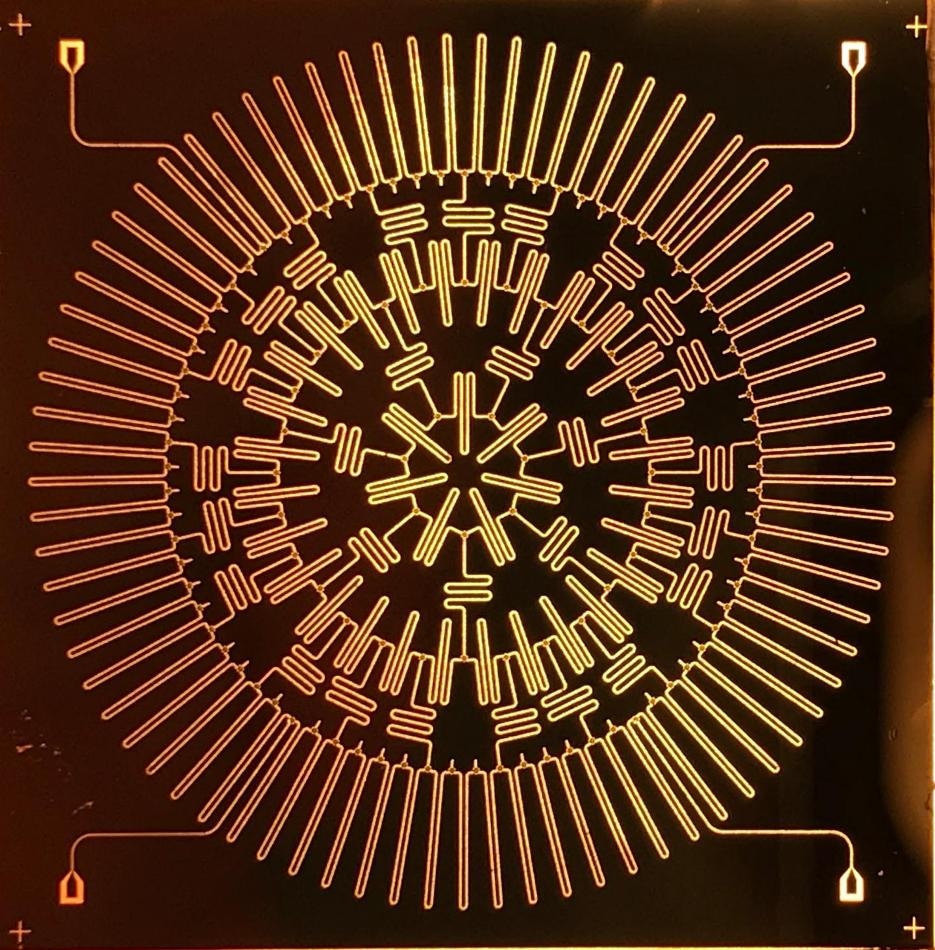Jul 25 2019
A U.S. Army project investigating new applications of superconducting resonators has found that these systems may be employed to mimic quantum materials that cannot be produced otherwise.
 A U.S. Army project at Princeton University results in an electronic array on a microchip that simulates particle interactions in a hyperbolic place, a geometric surface in which space curves away from itself at every point. (Image credit: Princeton University)
A U.S. Army project at Princeton University results in an electronic array on a microchip that simulates particle interactions in a hyperbolic place, a geometric surface in which space curves away from itself at every point. (Image credit: Princeton University)
Furthermore, they may offer insights into open and basic questions in quantum mechanics and gravity.
Researchers at Princeton University, headed by electrical engineering Professor Andrew Houck, fabricated an electronic array on a microchip that mimics particle interactions in a hyperbolic plane, a geometric surface in which space curves away from itself at each point.
This research may advance quantum simulation in a way that enables us to not only develop a better understanding of materials relevant to Army goals but also help us explore questions at the forefront of other fields of Army relevance.
Dr Sara Gamble, Program Manager, Army Research Office
Dr Gamble continued, “In addition to the potential materials applications, the fantastic results obtained by the research team can provide insight into communication networks and ultimately enable the DOD to develop more efficient networking capabilities.”
The Army Research Office is an element of the U.S. Army Combat Capabilities Development Command’s Army Research Laboratory.
The study, reported in Nature, employed superconducting circuits to produce a lattice that acts as a hyperbolic space. By introducing photons into the lattice, the scientists can answer a broad variety of complex questions by looking at the photons’ interactions in simulated hyperbolic space.
The problem is that if you want to study a very complicated quantum mechanical material, then computer modeling is very difficult. We’re trying to implement a model at the hardware level so that nature does the hard part of the computation for you.
Dr Alicia Kollár, Postdoctoral Research Associate, Princeton Center for Complex Materials
The chip, which is just 1 cm in size, is etched with a circuit of superconducting resonators that offer ways for microwave photons to travel and interact. The resonators on the chip are assembled in a lattice pattern of heptagons, or seven-sided polygons. The structure lies on a flat plane but replicates the atypical geometry of a hyperbolic plane.
In normal 3-D space, a hyperbolic surface doesn’t exist. This material allows us to start to think about mixing quantum mechanics and curved space in a lab setting.
Andrew Houck, Professor of Electrical Engineering, Princeton University
The effort to force a 3D sphere onto a 2D plane demonstrates that space on a spherical plane is smaller when compared to that on a flat plane. Hence, the shapes of countries seem elongated when sketched on a flat map of the spherical Earth. On the contrary, a hyperbolic plane would have to be compacted in order to fit onto a flat plane.
To replicate the impact of compressing hyperbolic space onto a flat surface, the scientists employed a unique kind of resonator known as a coplanar waveguide resonator. When microwave photons travel through this resonator, they act in the same manner regardless of whether their path is straight or twisty.
The twisty structure of the resonators provides flexibility to “squish and scrunch” the sides of the heptagons to generate a flat tiling pattern, stated Kollár, who is beginning a faculty position at the University of Maryland and Joint Quantum Institute.
A look at the central heptagon of the chip reveals that it is similar to having a look through a fisheye camera lens, in which objects at the edge of the field of view look smaller than at the center—the heptagons appear smaller as they move away from the center. This arrangement facilitates microwave photons that travel through the resonator circuit to act like particles in hyperbolic space.
The capability of the chip to replicate curved space could allow new studies in quantum mechanics, such as the study of the properties of energy and matter in the warped space-time around black holes.
Furthermore, the material could be helpful for gaining insights into complex webs of relationships in mathematical graph theory and communication networks. Kollár remarked that this study could ultimately help in the design of new materials.
However, initially, Kollár and her colleagues will have to further advance the photonic material, both by continuously investigating its mathematical foundation and by incorporating elements that allow photons in the circuit to interact.
“By themselves, microwave photons don’t interact with each other—they pass right through,” Kollár stated. The majority of the applications of the material would demand “doing something to make it so that they can tell there’s another photon there.”
“The research team is forming connections with researchers in other disciplines because of these results, and the addition of photon interactions into the systems will increase the application space for advancing Army capabilities even further,” Gamble stated.